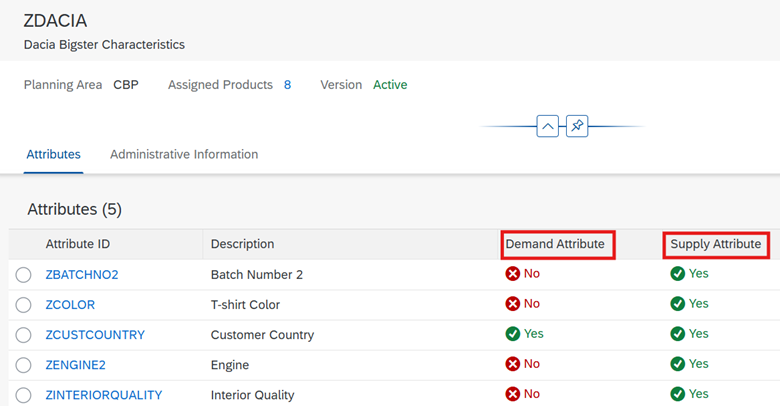Share this article
Follow us on Linkedin
Characteristics-Based Planning (CBP) in IBP is a newly-released approach that acts as a superglue, seamlessly pegging supply to demand elements based on user-defined characteristics rules, during the operational part of supply chain management.
This approach optimizes planning efficiency by reducing the need to extend the master data model with numerous product variants. Integration between SAP S/4HANA or ERP and IBP is performed via Real-Time Integration (RTI), ensuring precise alignment between the systems.
What are characteristics?
Characteristics are attributes or properties that define products, demands, and supplies in SAP systems.
With CBP, a range of characteristics can be considered in supply planning runs using the finite heuristic. Such characteristics can be product-related, such as size, color, or quality, or associated with other factors that help guide supply decisions, including special events, packaging, labeling, or sustainability.
Dacia Bigster
Examples of characteristics:
Product Characteristics: Color, Engine, Trim level, Wheel size.*
Demand Characteristics: Customer Region, Sales Channel, Seasonality.
Supply Characteristics: Lead Times, Supplier rating, Tire Type & Quality.
* IBP employs two types of Characteristics: Demand and Supply.
Examples of Demand / Supply Attribute setup in IBP.
Characteristics-Based Planning in IBP.
Characteristics-Based Planning (CBP) utilizes product-related ‘planning filters’ (Demand Characteristics) within Supply Planning Runs. Demand is pegged to Supply using rules defined in IBP, considering Characteristics values. These demand and supply characteristics are retrieved from SAP S/4HANA via RTI :
1. Stock (batches) – carry the supply characteristics (Product Color, Size, Quality)
2. Sales Orders / Forecast – carry the demand characteristics (Customer Type, Customer Region)
Advantages of using IBP Characteristics-Based Planning.
- Reduced master data complexity: fewer SKUs are needed.
- Improved forecast accuracy: Less noise, as all sales and forecasts are recorded on a single SKU.
- Ideal for high-customization scenario: Recommended for make-to-stock products with a high level of customization, such as in the automotive or clothing industries.
Use case scenarios for using IBP Characteristics-Based Planning
Scenario 1: supply matching:
In this example, a Sales Order must be fulfilled from existing stock, which consists of multiple batches with varying characteristics.
Based on the rules defined in the Characteristics-Based Planning Profile, the Sales Order will be pegged to the batches that match the predefined characteristics — for example, a specific type of engine (Hybrid) designated for shipment to German customers.

Scenario 2: supply creation:
But what about when supply is not sufficient to meet the demand?
Similar to supply matching, a set of rules has been defined to determine how supply is created (e.g., through planned orders or stock transfers) when existing supply is insufficient to meet demand.
In this example, planned orders will be generated to fulfill Sales Orders from German and Chinese customers. For German customers, planned orders for the hybrid engine will be created, while for Chinese customers, planned orders for the standard engine will be generated.
In multisource scenarios, Characteristics-Based Planning (CBP) provides the capability to define rules for selecting the optimal production plant or transportation lane.
Although the same SKU is sold (Dacia Bigster), different variants are produced in different plants:
- Hybrid engine: produced in Plant DE10
- Standard engine: produced in Plant DE20

For a deeper understanding of SAP IBP Characteristics-Based Planning, feel free to reach out to us.


